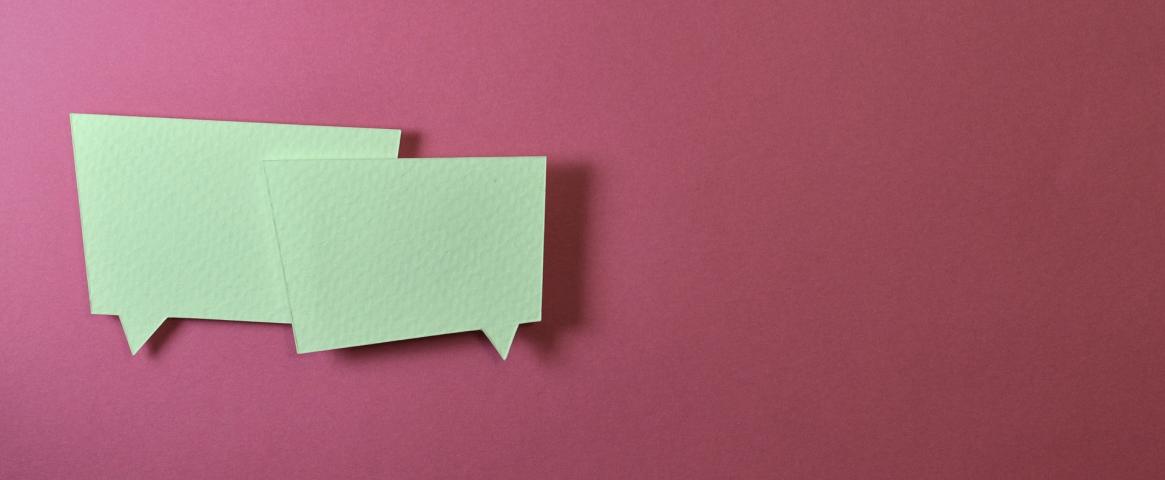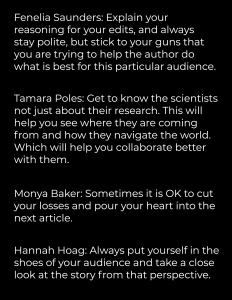By Alex Ip
For most people, the acronym “GDP” refers to Gross Domestic Product, a measure of economic power. However, for biochemists who pitch to Monya Baker, the Senior World View and Comment Editor for Nature, “GDP” could mean something totally different—guanosine diphosphate, an important compound for human metabolism.Such is the challenge of getting scientists to write and talk to a non-expert audience, as discussed in the “Editing experts: How to help scientists meet journalism standards” panel session at the ScienceWriters2021 conference.
Most scientists are used to publishing research papers for their peers, a process that could take years, allowing them to pore over every word in every sentence. No such luxury exists in writing popular science pieces that have a turnaround time of a few weeks or going to a carnival to speak to eager middle-schoolers. Here’s where science editors and communications specialists step in. Using their journalism expertise, they help scientists prioritize the audience without “dumbing down the science”.
“Why should I care?” is often the first question Tamara Poles asks beginner science communicators when they pitch her. Poles, the community engagement specialist at the Morehead Planetarium and Science Center in Chapel Hill, N.C., is adamant about scientists understanding what makes their specific audience tick—and what makes themselves tick too. She would usually sit down with them to understand their hobbies and passions. If there are things that experts and the audience can both relate to and get emotionally invested in, it is much easier to develop analogies that explain the science and build trust. “Never talk at the audience, and never assume that they understand your jargon.”
Hannah Hoag, the deputy editor at The Conversation Canada, asks scientists to summarize in one sentence why the story matters during the pitching process before a draft is even submitted, in order to get scientists thinking about the potential impact of their work, and using this as a guide during the editing process. Speaking of the editing process, the panelists emphasized the importance of transparency and the use of “benchmarks,” because the way it is done in academia, or even the way these publications have done it in the past, does not mean that is the way that serves the current audience.
Michael Lemonick, the recently retired Chief Opinion Editor of Scientific American, pointed out that Scientific American has transitioned over time from a highly technical publication to one with a significant online presence that has focused on popular science, controversies, and the sociology of science. That means resetting the expectations of scientists that may have grown up reading the magazine in print. One way he does it is to provide a marked-up copy of the draft back to scientists and explain the edits to them, not being afraid to challenge the experts in the field. “We are experts at what we do [too]. This is not a problem for us.”
Like Lemonick, Fenella Saunders, the Editor-in-Chief of American Scientist (not related to Scientific American), would politely and determinedly explain to scientists she works with how stylistic edits would make it clearer for the audience. In addition, she would ask experts to carefully read through captions and scale bars to make sure that they are accurate and presentable. To grease the wheels, she would further complete an author agreement that lays out the timeline and expectations. Publication is not guaranteed upon acceptance of a draft at American Scientists unless scientists put in the work to reframe their work that resonates with their intended audience.
However, the conclusion of the editing process, whether resulting in publication, a scientist having cold feet, or editors walking away from a story, is not the end of the road. The editors on the panel shared a common goal of helping the scientists they work with, many of which lack prior exposure or come from marginalized backgrounds, gain the skills to become confident communicators in their own right. Baker would pick compelling quotes from phone conversations with scientists and read the quotes back to them, providing them with aces up the sleeve were another writing opportunity to arise. Poles, of Morehead Planetarium, would send outstanding past samples, some from colleagues to her scientists, in order to help them learn best engagement practices from one another.
Hoag believes that persistence is ultimately the key to succeeding in this balancing act of “meeting them where they are at” -- editors and scientists bridging the gap, or scientists finding common ground with their audience. There is no reason why the wonders and obstacles of science can’t be understood by more people if the effort is put in.
Or as Poles put it, “when you construct a building, why wouldn’t you put in elevators and accessible ramps?”
Born and raised in Hong Kong, Alex Ip (@alexip718) is the Editor In Chief at The Xylom, a student-run nonprofit creating personal stories of science and humanity. A NASW Diversity Fellow in 2021, he has also written for the Georgia Tech Global Change Program. Like most science writers, Alex is a big fan of basketball, maps, and chonky cats.
Hero image by Miguel Á. Padriñán from Pixabay.




